One thing that was clear after Hugh Tracey’s decades of research into the many types of traditional kalimbas in Africa was that a large proportion of them – about 40% – were in pentatonic tunings. This is one of the reasons why Hugh Tracey kalimbas are available in several pentatonic models.
What’s so great about the pentatonic scale? Well, with fewer notes (just five per octave), it is conceptually simple, for one. And the Hugh Tracey kalimbas carry that simplicity through to make it physically simpler to play – with larger gaps between the tines, it is easier to play the tine you intended to, meaning that everything is simpler, and you can just relax and really cut loose.
And that is really it – playing on a pentatonic scale, you are able to really let go and improvise and play without thought and without being self-conscious. Simply liberating!
It turns out there are a great many different pentatonic scales that different primitive peoples from around the world have used. We are only scratching the surface here with the major and minor pentatonic tunings. In addition to these, we also offer the Japanese Ake Bono tuning and an African tuning in F7 by Francis Bebey.

Here is the paradox about the pentatonic tunings: with fewer notes, you have fewer musical possibilities, which seems undesirable. However, the remaining notes paint a clearer picture of some ethnic-sounding music-scape. And that is what I find beautiful about these pentatonic tunings, as if each one takes you to a different land.
This article gathers, in one place, all the pentatonic kalimba books, instructional downloads, and pentatonic kalimba models, for a great overview of what’s available in the unique and fun pentatonic universe.
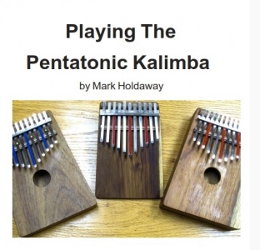
The pentatonic kalimba is a great instrument for jamming and improvising, because no matter what you do, it always sounds wonderful. If you’re interested in a more structured learning experience on playing technique for the Hugh Tracey 11-note pentatonic kalimba that includes things like riffs, patterns, and symmetry then this is the book you want.
The first half of this book covers the G major tuning, and the second half of the book covers G minor tuning (which you can accomplish yourself).
75 exercises in 48 pages, B/W photos, CD included.
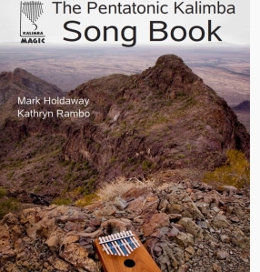
The “Pentatonic Song Book” is a good complement to “Playing the Pentatonic Kalimba” (which deals more with structured “how-to.”) The Song Book covers well-known songs that you and your family will know. Songs are written in both kalimba tablature and in standard staff notation. This is a great book for players of all levels. To use this book you need to have the Hugh Tracey Pentatonic Kalimba (or a similarly tuned instrument).
Songs include: “Amazing Grace,” “Auld Lang Syne,” “Bought Me A Cat,” “Camptown Races,” “Daniel in the Lion’s Den,” “Go Tell it on the Mountain,” and much more.
64 pages, CD included.
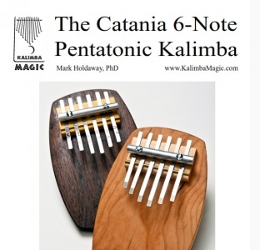 This simple numbers-based book for the 6-Note Pentatonic Kalimba can be used as a starting point for almost every kalimba we sell, great for kids or absolute beginners. Write the note numbers on the corresponding tines with Sharpie marker and then just “play by numbers.”Visit Product Page
This simple numbers-based book for the 6-Note Pentatonic Kalimba can be used as a starting point for almost every kalimba we sell, great for kids or absolute beginners. Write the note numbers on the corresponding tines with Sharpie marker and then just “play by numbers.”Visit Product Page
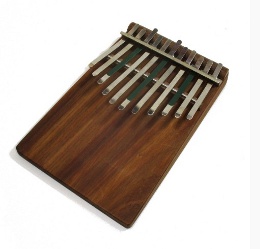 Wild and fun! This is a great instrument for beginners. Playing it is very physical.
Wild and fun! This is a great instrument for beginners. Playing it is very physical.
The pentatonic scale is also called the “no-fault scale.” It is a simplified scale with just five notes. You can play in G major or E minor.
This is an excellent kalimba for people with little or no musical experience, but experienced musicians can really fly on this one, as the pentatonic scale lets you apply all your speed and shine almost without you having to think at all (yes, you remember the “blues scale” on guitar — this is it!)
The small sound board is well-suited for small hands or children. The small board also permits using the right index finger up-stroke method typically used in mbira playing. A nice trick to increase the volume is to hold it against a window or a table as a sounding board.Visit Product Page
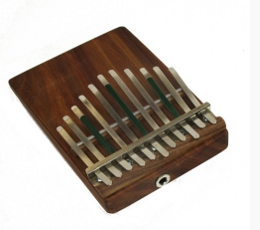 Wild and fun, with an electronic pickup to boot! I suppose that would make this one wilder and funner.Visit Product Page
Wild and fun, with an electronic pickup to boot! I suppose that would make this one wilder and funner.Visit Product Page
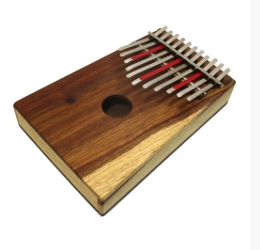 This kalimba has the same notes as the celeste pentatonic kalimba, but rather than a solid board, it is built on the same resonant box that the Alto kalimba is built on. By covering and uncovering the sound holes on the resonant box, you can accomplish vibrato and “wah-wah” effects, adding to the mystical sound and feel of the pentatonic kalimba.Visit Product Page
This kalimba has the same notes as the celeste pentatonic kalimba, but rather than a solid board, it is built on the same resonant box that the Alto kalimba is built on. By covering and uncovering the sound holes on the resonant box, you can accomplish vibrato and “wah-wah” effects, adding to the mystical sound and feel of the pentatonic kalimba.Visit Product Page
 The exotic Box Pentatonic kalimba, with an electronic pickup (PU) installed.Visit Product Page
The exotic Box Pentatonic kalimba, with an electronic pickup (PU) installed.Visit Product Page


Sign up for our newsletter and free resources with your email address:
We pinky promise not to spam you and to only send good stuff.
 Christmas in July 2025
Christmas in July 2025 Patriotic and American Music for Kalimba
Patriotic and American Music for Kalimba